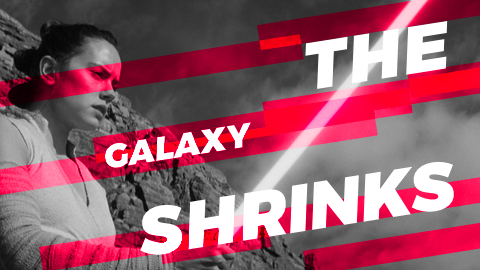We live under the tyranny of the Porgs. How can anyone look at the current release schedules of all future “Star Wars” movies and not feel at least a little depressed? Year after year of uninterrupted Star Wars with absolutely no respite. At least George Lucas gave us the courtesy of waiting a few decades before giving us the prequels. But now that he has signed away his creative properties to Mickey Mouse, the demonic rodent himself, we are locked in a permanent Force Grip and I’m about to suffocate.
Look, it’s fine, alright? Is that what you wanted to hear? “Star Wars: The Last Jedi” is a perfectly watchable movie. Any film that angers the chinless involuntary celibates of the world because it disrupts their power fantasy has to have at least some merit. It’s certainly better than its predecessor, “The Force Awakens,” one of the insidiously focus-grouped, mediocre, consequence-free, meaningless films in recent memory.
Unlike the last movie, “The Last Jedi” has the decency to actually be about something meaningful. Rey (Daisy Ridley) tracks down the famed Jedi Master Luke Skywalker (Mark Hamill) in order to seek his aid against The First Order, the evil organization that aims to finish what Palpatine’s Empire started.
Luke’s response – where he chucks his father’s lightsaber off a cliff – says it all. Jaded after his nephew Ben Solo fell to the Dark Side and became the Darth Vader cosplayer Kylo Ren (Adam Driver), Luke comes to the conclusion that the endless conflict between the Light Side and Dark Side of the Force is irresolvable so long as its physical representations, the Jedi and the Sith, continue to exist.
Therefore, it is time for both to end, as the Force encompasses all – not just an elite few. This narrative approach is a surprisingly mature take for a major motion release, and it’s easy to see why this decision, which devalues the primacy of the individual, angered so many. After all, isn’t the resolution between two opposing forces (a thesis and antithesis) in order to create a harmonious synthesis the nature of dialectics? Perhaps the mopes from 4chan were right and the new Star Wars really was part of a cultural Marxist conspiracy after all!
The best part of the film is indisputably Hamill’s performance as the aging, bitter Luke Skywalker. Hamill’s gravelly old man-voice and dead-eyed cynicism acts as an excellent contrast to his younger hot-headed self, and Hamill brilliantly portrays a man whose optimism has slowly withered away after decades of disappointment and loss.
Carrie Fisher, may she rest her soul, is wonderful as General Leia as well; she demonstrates the psychological flip side of the aging process, where the horrors she has endured and the struggles she’s been through have only strengthened her faith in goodness rather than weakened it. Her honest performance is best demonstrated during a sequence where Leia uses the Force to float through space – a scene that is so over-the-top nakedly, achingly sincere that of course it would inspire cynical jeers from those that cannot handle such pure mystique.
Yet these performances, as good as they are, also highlight another of the sequels’ core flaws. It’s not a good sign in a series that’s supposed to continue a grand legacy when the old characters are far more interesting than the new ones. Though John Boyega, Oscar Isaac and Ridley are wonderfully charismatic performers, – and if they approached me with some kind of contract for a four-way polyamorous domestic partnership, I’d sign it in a heartbeat – no charm can disguise the underwritten, one-dimensionality of their characters. (To say nothing of the complete worthlessness that is BB-8, a shameless merchandising gimmick even by “Star Wars” standards.)
Still, it’s an impressively bold move for one of the biggest cinematic juggernauts to claim that one of its most iconic staples – the Jedi – must be abolished. Director Rian Johnson, a director known to make huge dramatic leaps (for example, a high school potboiler with Joseph Gordon-Levitt as a teenage detective and a time-travelling sci fi movie who grows up into Bruce Willis) uses the trademark staples that he grew up with in order to forge bold new pathways into the galaxy.
One may even be so bold enough as to view “The Last Jedi” as a direct response to all the criticisms raised in my piece. Rather than languish in old cultural signifiers (as “Rogue One” did), “The Last Jedi” wants to create something new.
In the end, it’s profoundly depressing that the “Star Wars” universe feels smaller than ever. There’s no real sense of scale or wonder. All of the planets are either non-descript or blatant knock-offs of better-known worlds like Hoth or Coruscant. Even more stultifying is the shockingly uninspired alien designs. One of my favorite movie scenes to this day is the Mos Eisley Cantina scene, where a variety of strange and striking alien beings revealed just how much of a Pandora’s Box this universe was and how much more it had to reveal.
“The Last Jedi” tries to replicate this scene with a trip to a Vegas-themed planet, but it’s undermined by the fact that every alien looks like the same uninspired, toad-faced muppet. (What good are “practical effects” in this case if all the effects look identical?) Yes, the prequels are abject messes. Yes, Gungans and Midichlorians were unfortunate creative decisions. But at least they were new. They crashed and burned, but only because their creators flew too close to the sun. It’s admirable that Johnson and producer Kathleen Kennedy took a risk by claiming to throw out the old, yet that decree rings hollow when what’s new is so sickeningly safe.
Still, the film’s departing scene, where a little Force-sensitive stable boy looks up at the night sky, recalls those early moments in “A New Hope” where, from the slump of his moisture farm, young Luke looks on as the twin suns rise over Tatooine’s horizon. It gives me hope that one day, some creators will remember just how big the galaxy really is, but so long as “Star Wars” is under the devil’s control, I doubt it.
Nate Taskin can be reached at [email protected] and followed on Twitter @nate_taskin.




















